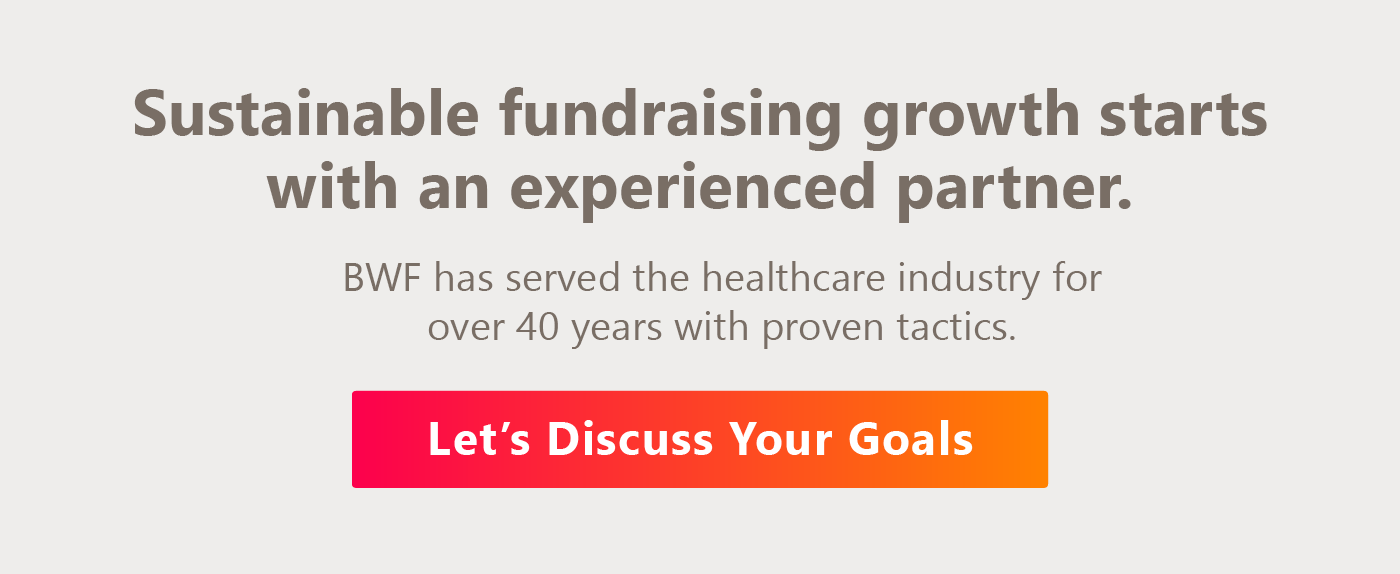For your healthcare organization to run like a well-oiled machine, it needs funding from various sources—not just patient fees and insurance reimbursements. Like how nonprofits require donations to work toward their missions, healthcare fundraising is essential to continue delivering a quality experience and resources to your patients and community members.
Fortunately, many donors see the value in giving to healthcare organizations like yours. BWF’s 2023 healthcare study shows that 78.2% of high-income donors prioritize healthcare when determining where to direct their charitable giving.
This comprehensive guide covers everything you need to know about the healthcare fundraising landscape in 2025 and expert strategies to increase funding this year. We’ll review:
- Healthcare Fundraising: Q&A
- Challenges and opportunities for healthcare fundraising in 2025
- 7 proven healthcare fundraising strategies to raise more
- How to get expert healthcare fundraising help
These best practices and insights are designed to revitalize your fundraising, equipping you with the resources and strategies you need to raise more sustainably over time.
Healthcare Fundraising: Q&A
What is healthcare fundraising?
Healthcare fundraising is the revenue-generating strategy healthcare organizations and hospitals use to fund their essential needs. It involves all funds collected outside direct payments, which are patient bills, retail services, and private or public insurance reimbursements. Instead, healthcare fundraising gathers charitable donations from various sources, including individuals, governments, foundations, and corporations.
Why is healthcare fundraising so important?
Healthcare organizations need to supplement their other revenue-generating activities with fundraising for the following reasons. Fundraising can help you:
- Scale up operations and build your facilities to serve a broader patient audience.
- Update outdated technology and use innovative new solutions.
- Cover operational costs not covered by insurance or patient payments.
- Pursue advanced medical research.
- Support programs in the broader community that help improve community health.
- Offer expanded professional development opportunities to boost employee engagement and job satisfaction.
How does healthcare fundraising actually work?
To grasp the healthcare fundraising process, it’s essential to understand the key players and strategies involved in identifying potential funding sources, gathering donations, and effectively utilizing the funds. First, let’s identify the common sources of healthcare funding and how organizations deploy this money. We will discuss strategies for securing funding in a later section.
Sources of healthcare funding
According to the Giving USA 2024 report, contributions to the healthcare sector reached an all-time high in 2023. The healthcare industry received $56.58 billion in philanthropic gifts, with 4.4% inflation-adjusted growth, surpassing 2021’s previous record-setting total of $56.20 billion.
The report highlights the top sources of this funding:
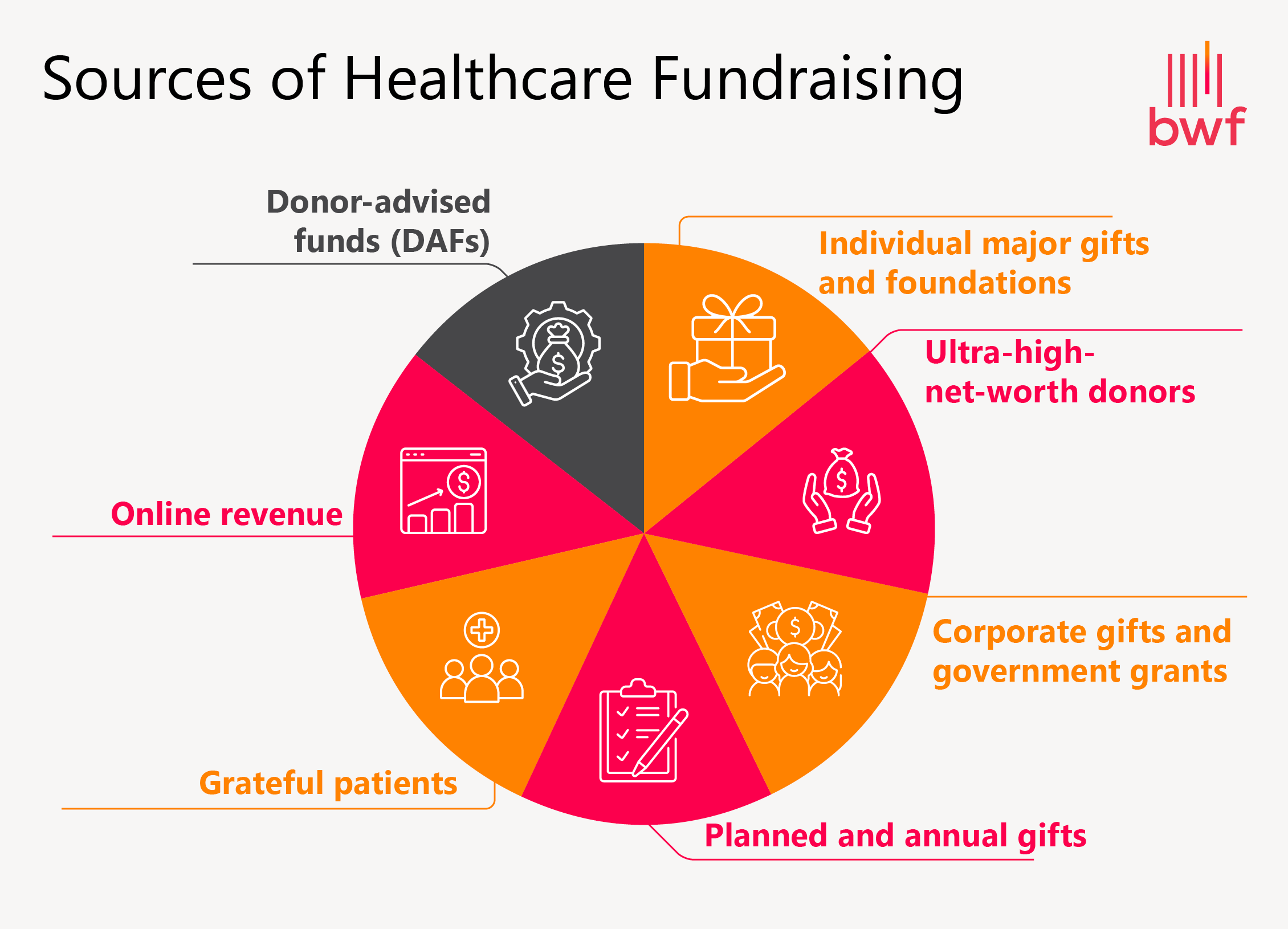
- Individual major gifts and foundations: Research shows that healthcare organizations depend on major gifts for about 43.4% of donations.
- Ultra-high-net-worth donors: Major donors like Mackenzie Scott and Michael Bloomberg donated billions of dollars to healthcare organizations in 2024.
- Corporate gifts and government grants: According to the AHP 2024 Report on Giving, high-performing healthcare organizations receive significant funds from corporate and government sources. Corporate gifts comprise 32% of the total production revenue for high-performing organizations, compared to 24% for all study participants. Similarly, government funding accounts for 17% of their revenue, compared to 12% for all respondents.
- Planned and annual gifts: According to Giving USA 2024, bequests grew to $42.68 billion in 2023 and were the only source of giving to outpace inflation.
- Grateful patients: Grateful patient programs allow patients who have had an outstanding experience to show gratitude and give back to your organization.
- Online revenue: According to the 2024 Digital Fundraising Benchmark Report for Hospitals, online donor retention rates for healthcare organizations increased 20% year over year from 2022 to 2023, showcasing the loyalty of digital supporters. Plus, the volume of new online donors grew 10% despite a 30% decline in overall donors.
- Donor-advised funds (DAFs): Giving USA found that giving to foundations saw the most significant growth rate at 10.8% (adjusted for inflation). Investments from donors in community foundation-held Donor Advised Funds (DAF) partly fueled this growth.
How healthcare organizations use funding
Once organizations gather donations, what do they use them for? Here are some of the most pressing fundraising needs in the healthcare sector this year, based on recent reports:
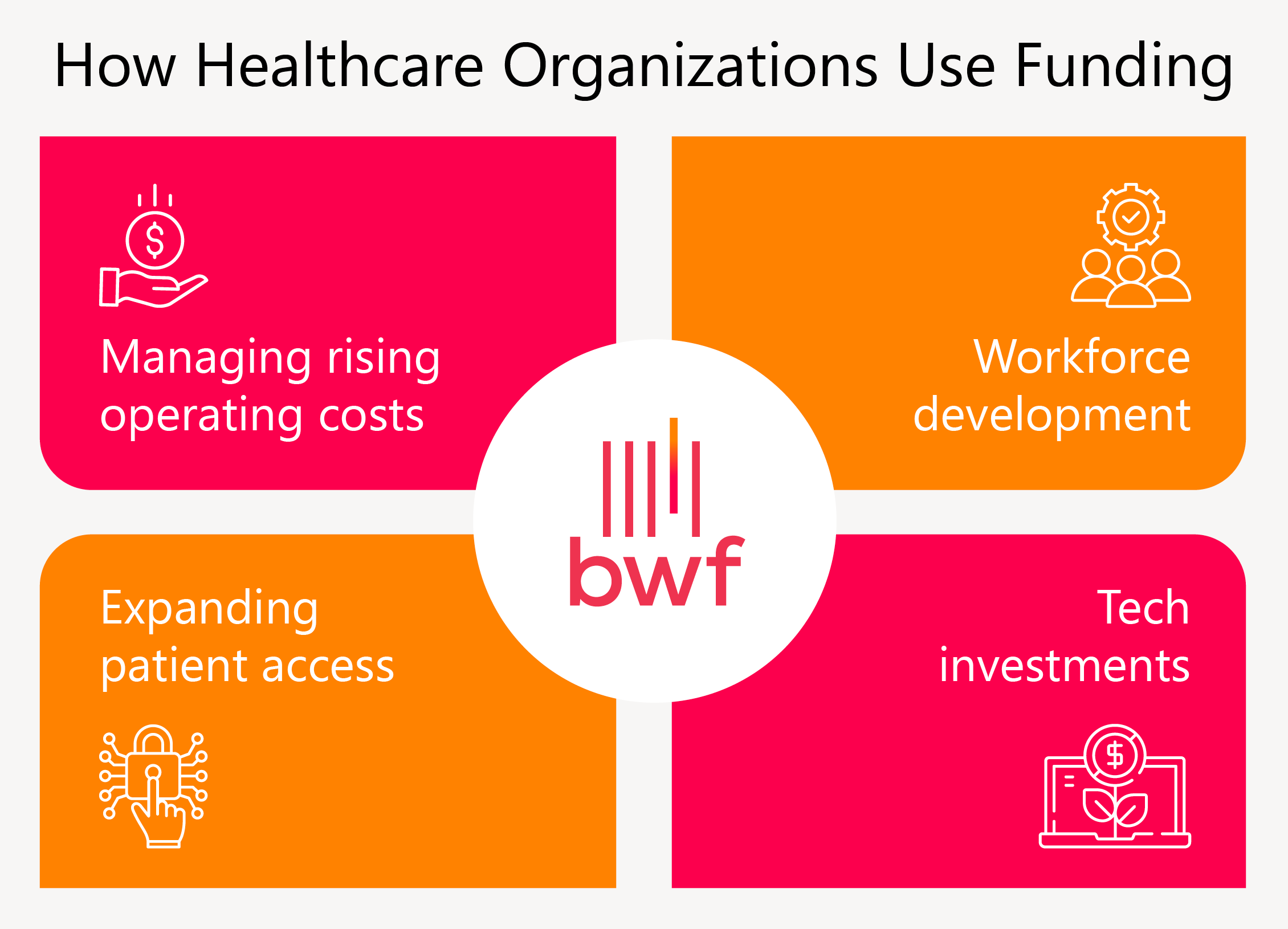
- Managing rising operating costs. Costs for administration, essential services, drugs, supplies, and labor have all increased over the past few years. Hospitals need a steady flow of diversified funding to keep up with rising expenses while providing the quality experience their communities need.
- Workforce development. Deloitte’s 2025 US Healthcare Outlook found that more than half (58%) of health system executives expect workforce challenges, including talent shortages, upskilling needs, and retention issues, to influence their organizational strategies in 2025. The report recommends that healthcare organizations invest in unifying core technologies, modernizing their data, updating their governance structures, and creating equitable access to technology to improve the staff and patient experience.
- Tech investments. Deloitte’s report also found that around one-third of healthcare executives identified technology investments as a priority for 2025. Offering user-friendly patient portals, stringent cybersecurity measures, and greater patient convenience are all tech investments organizations can make to create a better patient experience that encourages retention.
- Expanding patient access. According to Vizient’s annual survey of hospital and health system leaders, 52% see patient access, throughput, and capacity as their top focus area for 2025. Investments in identifying social determinants of health (SDOH), emphasizing longitudinal care, and simplifying patient experiences are all areas healthcare organizations are directing funding toward this year.
Challenges and opportunities for healthcare fundraising in 2025
Understanding the current healthcare fundraising landscape is important so your organization can navigate external factors effectively and continue to raise funds from the right sources. Here’s a brief overview of the obstacles and opportunities your healthcare organization may encounter this year:
Challenges
- Medicaid disruptions. Uncertainty about the future of long-standing healthcare programs like Medicaid has left healthcare providers uncertain whether they can rely on certain forms of government support.
- Slowdowns in funding for biotech startups. According to the Wall Street Journal, investments in biotech ventures are recovering from a recent drop, but investors are still cautious about how long the upswing will persist.
Opportunities
- Private sector stepping up amid government uncertainty. Due to the shifting political climate, the private sector and individuals have stepped up to alleviate funding dips. For example, according to a Reuters article, “The Global Fund to Fight AIDS, Tuberculosis and Malaria told Reuters it will ask for almost 50% more money from private entities, including philanthropic organizations and companies, for a total of $2 billion.”
- Fundraising tech advancements. AI fundraising solutions, such as predictive modeling tools, streamline how healthcare organizations approach fundraising, helping increase accuracy and efficiency. Healthcare use cases for AI include donor prospecting and grateful patient identification.
In the next section, we’ll highlight strategies your organization can use to overcome these challenges and maximize these opportunities.
7 proven healthcare fundraising strategies to raise more
These strategies will help you develop a reliable fundraising pipeline for your healthcare fundraising needs that can facilitate long-term growth.
If you need greater support to implement these techniques more effectively, don’t hesitate to connect with a healthcare fundraising consultant. These experts can assess your unique needs and develop a plan suited to your distinct donor base.
1. Strengthen your internal systems and analytics.
Any effective fundraising campaign starts with a strong internal data and analytics database. Most organizations use a robust constituent relationship management system (CRM) to track donor data and leverage personalized audience insights.
That said, CRMs can be complicated and require training to master. To get on the right track quickly, consider hiring a fundraising CRM and data analytics consultant to help clean up your internal database and revitalize your analytics approach.
For example, the fundraising consultants at BWF worked with University Hospitals to help the organization develop an internal analytics program. BWF conducted the following tasks to provide a 360-degree assessment of the organization’s current analytics approach:
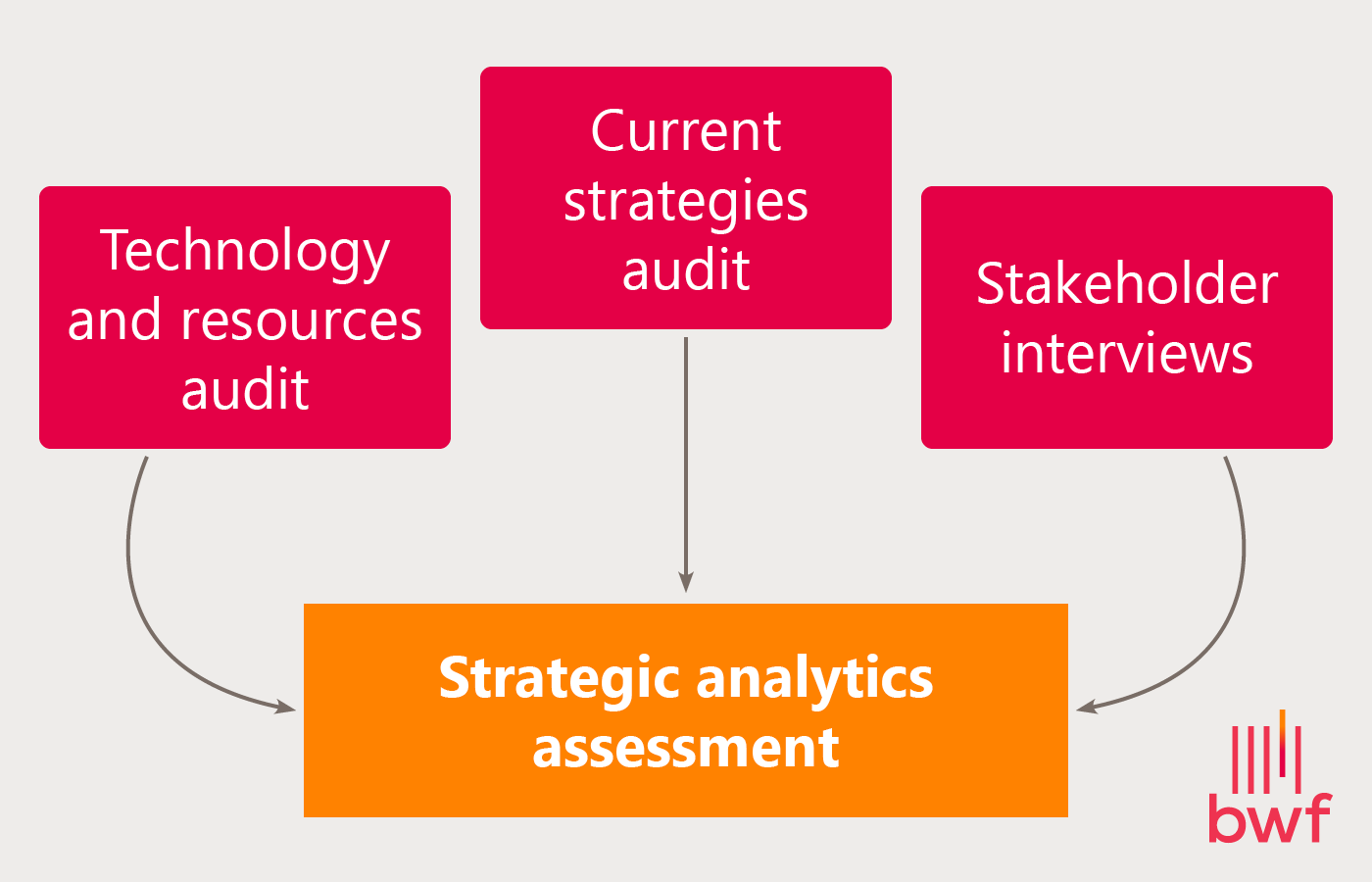
- Technology and resources audit
- Current strategies audit
- Stakeholder interviews
Ultimately, the BWF team created a plan to optimize the organization’s capabilities regarding analytics skills and resources, production, awareness, and utilization. BWF also helped each staff member understand their roles and responsibilities within the new program and set milestones to track progress.
Explore BWF’s data science and analytics services
2. Build prospective donor segments.
A donor segment is a group of donors sharing similar characteristics. Developing donor segments will allow you to create more personalized, targeted marketing messages that resonate with the motivations and needs of each unique group.
You can use AI tools and predictive analysis to develop donor segments. These solutions help identify shared characteristics within your donor base and automatically group donors based on their similarities.
You can also leverage data such as SEC filings, real estate ownership, stock holdings, past philanthropic giving, political affiliations and donations, past interactions with your organization, and demographic information to identify each donor segment’s varying giving capacities and likelihood.
Create segments for different types of donors, such as:
- Grateful patient donors. A grateful patient program involves engaging former patients in donating to your healthcare organization. Potential grateful patient donors are patients who have expressed great appreciation for their care and want to donate.
- Major donors. Potential major donors usually exhibit several wealth markers, such as real estate holdings or large donations to similar philanthropic organizations. These donors may be former patients, business leaders, or other community members who have given to similar organizations in the past.
- Planned or legacy donors. A planned or legacy donor is someone who plans to contribute a large donation in the future, typically as a bequest. These donors are usually supporters who have shown longstanding support for your organization, a higher giving capacity, and the motivation to leave a lasting legacy through their donation.
- Corporate sponsors. Corporate sponsors are individuals who own businesses in your area and are looking to partner with philanthropic organizations. Businesses benefit from these partnerships by improving their public image and accessing a new audience of potential customers.
Build out each segment with a unique name, demographic and employment information, relative giving capacity, history of involvement with your organization, and other information that will help you understand these groups more deeply.
3. Develop healthcare philanthropy predictive models.
Fundraising predictive models, also known as predictive analytics, anticipate donors’ future behaviors. By analyzing behaviors like donor giving patterns and retention data, these models can help predict the outcomes of fundraising campaigns.
In healthcare, dynamic predictive analysis is essential since the target audience is growing and changing much more rapidly than it would for other organizations, such as higher education institutions. Demographic shifts, research breakthroughs, new disease threats, and environmentally related health issues can bring more attention to your organization and, therefore, greater fundraising support.
The most popular healthcare predictive models tend to be the same as all other philanthropic sectors, including models for:
- Major giving
- Planned giving
- Principal giving
- Annual giving data (such as acquisition, renewal, upgrade, and channel preferences)
The healthcare sector also uses unique models, such as those for grateful patient acquisition, and areas of support, such as research, capital, and endowed chairs.
The BWF team has fostered several successful partnerships with healthcare organizations to optimize their data analytics and predictive modeling. For example, our partnership with Spaulding Rehabilitation Hospital yielded a set of custom-engineered models based on the organization’s unique audience. Thanks to the accuracy of the scoring process, the organization was even able to successfully re-engage a lapsed donor.
BWF has also been a strategic partner for Massachusetts General Hospital since 2010. This longstanding collaboration has allowed the hospital to leverage expert data analytics at a much lower cost than bringing on a new full-time staff member.
Learn more about our predictive analytics tool in this webinar, and contact our team if you’re interested in getting started.
4. Build a powerful grateful patient program.
After receiving stellar care from your healthcare organization, some patients may feel compelled to give back to your organization in return. A grateful patient program is a fundraising program for healthcare facilities to build relationships with patients whose lives have been positively impacted by healthcare services.
Use these tips to build a strong grateful patient program:
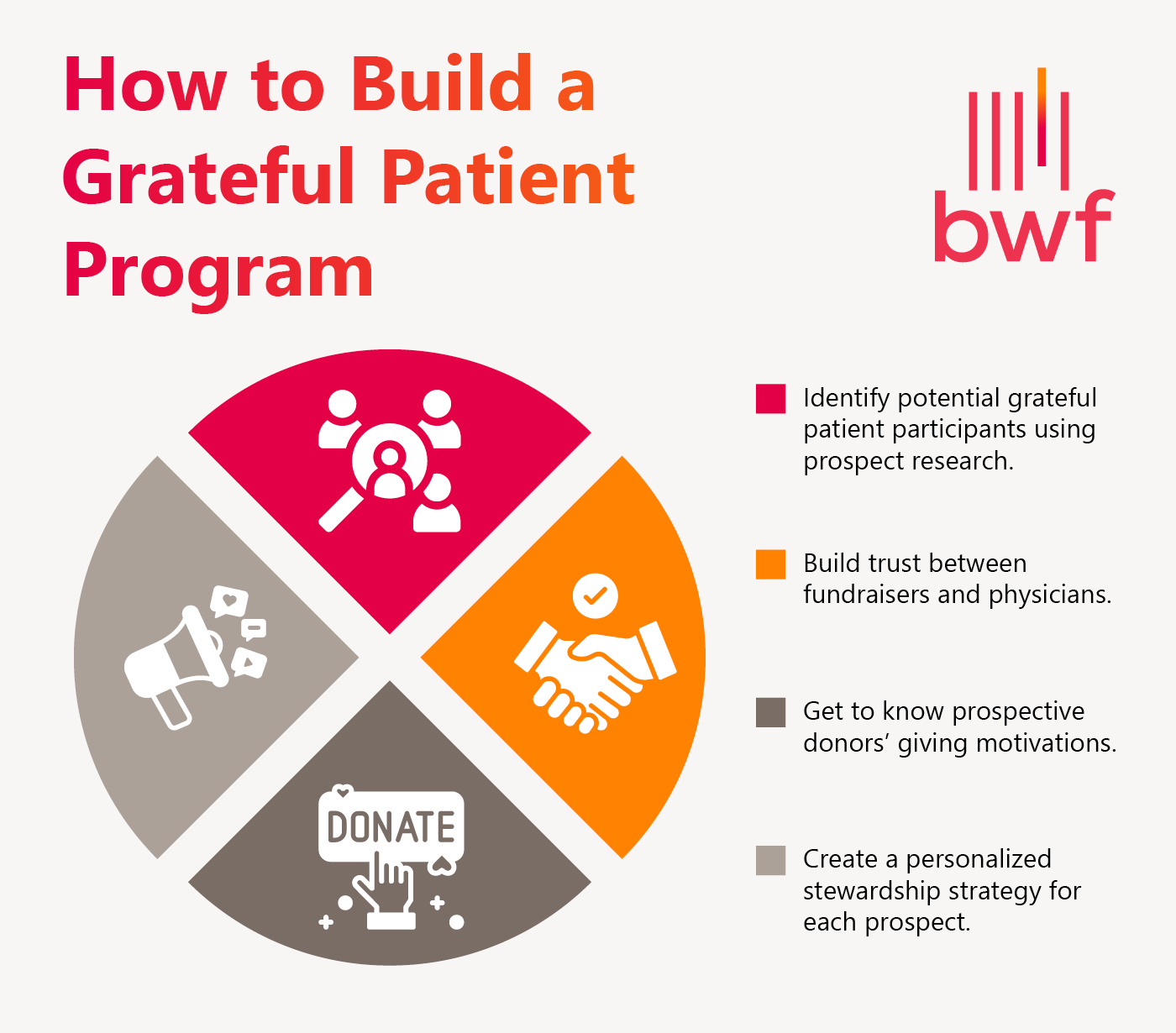
- Identify potential grateful patient participants using prospect research. Use your donor segments to identify potential grateful patient donors within your CRM. Search for audience members with a history of positive interactions with your organization and a greater giving capacity.
- Build trust between fundraisers and physicians. Doctors, nurses, and other healthcare professionals are essential in creating positive patient experiences. Fostering trust and mutual goals between fundraisers and healthcare professionals can make identifying potential grateful patient donors easier. Build this trust by giving doctors insight into how the grateful patient identification process works and how the development team is committed to keeping patient information secure every step of the way.
- Get to know prospective donors’ giving motivations. Understand which aspects of your organization appeal to prospective donors the most. Do they have a powerful relationship with one of your physicians? Did they spend much time in your children’s wing as a teen? Offer giving opportunities that resonate with their passions and interests.
- Create a personalized stewardship strategy for each prospect. Reach out using their preferred communication channels. Develop a suggested giving amount that is commensurate with the prospect’s giving capacity and relationship with your organization.
By creating a positive giving experience for patient donors, you can inspire them to become ambassadors for your organization and share their connection to your cause with their family and friends. They may also inspire other patients to give, helping your organization foster a reliable revenue stream that’s fully supporter-powered.
5. Be aware of the challenges associated with healthcare fundraising.
In addition to the timely challenges mentioned above, healthcare organizations face ongoing difficulties based on the nature of their work. Health is a deeply personal topic, and healthcare organizations must navigate the unique challenges of working with individuals who may be in vulnerable situations.
Common challenges for healthcare fundraising include:
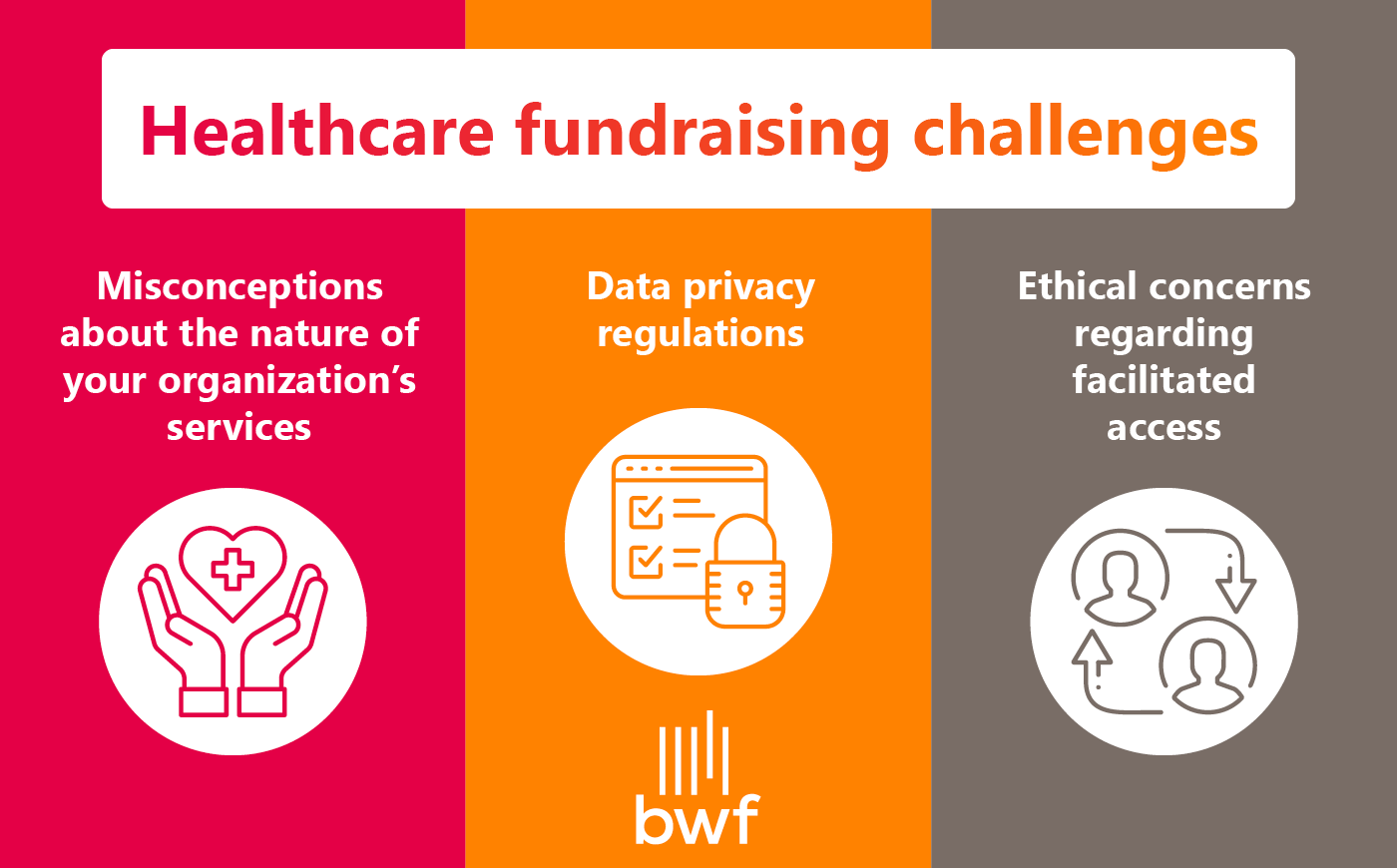
Misconceptions about the nature of your organization’s services
Fostering trust with community members is essential for successful healthcare fundraising, but it can be challenging if your organization offers specialized or unique services.
For example, academic medical centers often face misconceptions about their missions. People often consider these centers training grounds for inexperienced practitioners or fear that going to an academic institution for treatment will be much more expensive than going to their community hospital.
To debunk myths and rumors, fundraising professionals at AMCs need clear messaging and cohesive communication tactics. These organizations should highlight their benefits, such as innovative treatments and better patient outcomes. Show your target audience that your organization puts patients and the community first in every situation.
Data privacy regulations
Plenty of regulations safeguard protected patient information, such as HIPAA and HITECH.
Healthcare fundraisers must find ways to promote their missions and share patient stories without violating patient privacy or other relevant regulations.
Ethical concerns regarding facilitated access
Facilitated access involves providing greater support and streamlined healthcare access to a donor (or their family member or other associate).
Healthcare organizations receive many requests like this, so it can be helpful to establish a program to help sort and respond to these inquiries. At the same time, these requests can generate ethical concerns from other community members about donors receiving a higher level of care.
It’s important to carefully consider the pros and cons of a facilitated access program for your organization. Assess how such a program could fit into your organization’s culture and values. If you decide to continue offering or start a facilitated access program, anticipate potential reactions from community members and determine how you’ll respond to them.
6. Foster community partnerships.
Through collaboration and stronger local ties, strategic community partnerships set your organization up for success. These partnerships can lead to greater visibility for your mission and reliable fundraising streams.
Build partnerships with community members and organizations such as:
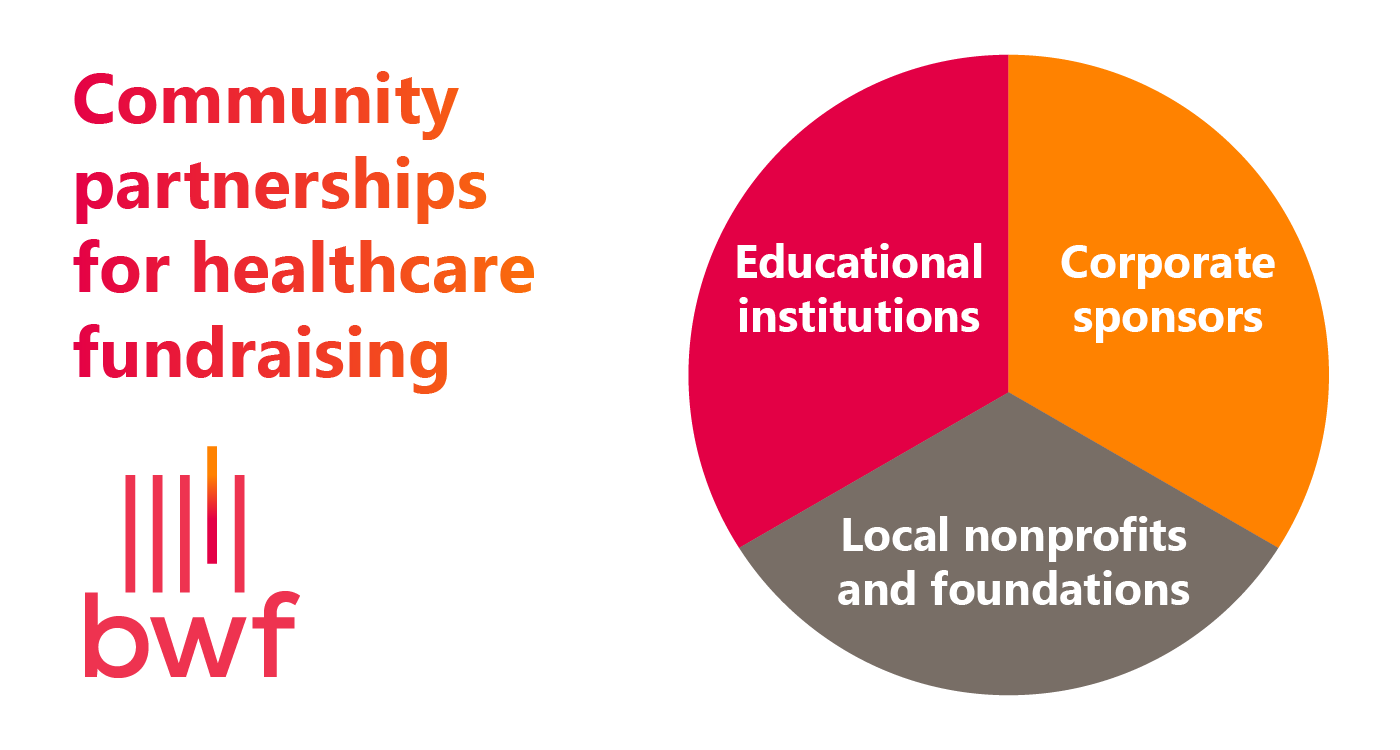
- Corporate sponsors. Strong partnerships with local businesses offer financial support and access to a new audience of their customers and employees who may become donors and volunteers. Many businesses also offer matching gift programs that your organization may qualify for. In these programs, companies match donations their employees make to philanthropic organizations. It can also be beneficial to form relationships specifically with healthcare suppliers—these businesses may offer in-kind donations to support your mission.
- Local nonprofits and foundations. Ties between nonprofits and healthcare organizations can be very strong, especially since many nonprofits have a health focus. Team up with relevant nonprofits in your local area to cohost events, such as fundraising runs or walks. This can increase awareness of your mission and ways to support your organization.
- Educational institutions. Partnering with research facilities or universities can facilitate joint research and increase funding for your programs.
Your efforts to engage with other local organizations will help increase trust among community members and elevate your fundraising efforts.
7. Maintain healthcare fundraising transparency.
Stakeholders, such as donors, grant funders, foundations, and community organizations, need to know how your organization uses donations to promote your mission.
They need to know that they can trust your organization to handle their funds wisely and that you direct the majority of your funding to programs that directly benefit your mission.
A clear transparency approach gives credibility to your fundraising efforts and develops trust with community members.
Maintain a high level of accountability to stakeholders by taking the following steps:
Publish an annual report on your website
An annual report recaps your fundraising efforts, demonstrates the good work you’ve been doing with the community’s support, and provides a clear look at your financial situation. Your annual report should provide an at-a-glance view of your major projects throughout the year. It’s also an opportunity to thank your donors, volunteers, and other supporters and let them know you couldn’t have grown your programs without their help.
The best annual reports provide clear numbers related to the organization’s financial health. For example, check out LifeLong Medical Care’s 2024 digital annual report. The webpage offers multiple charts depicting the organization’s impact on the community, revenue, and expenses.
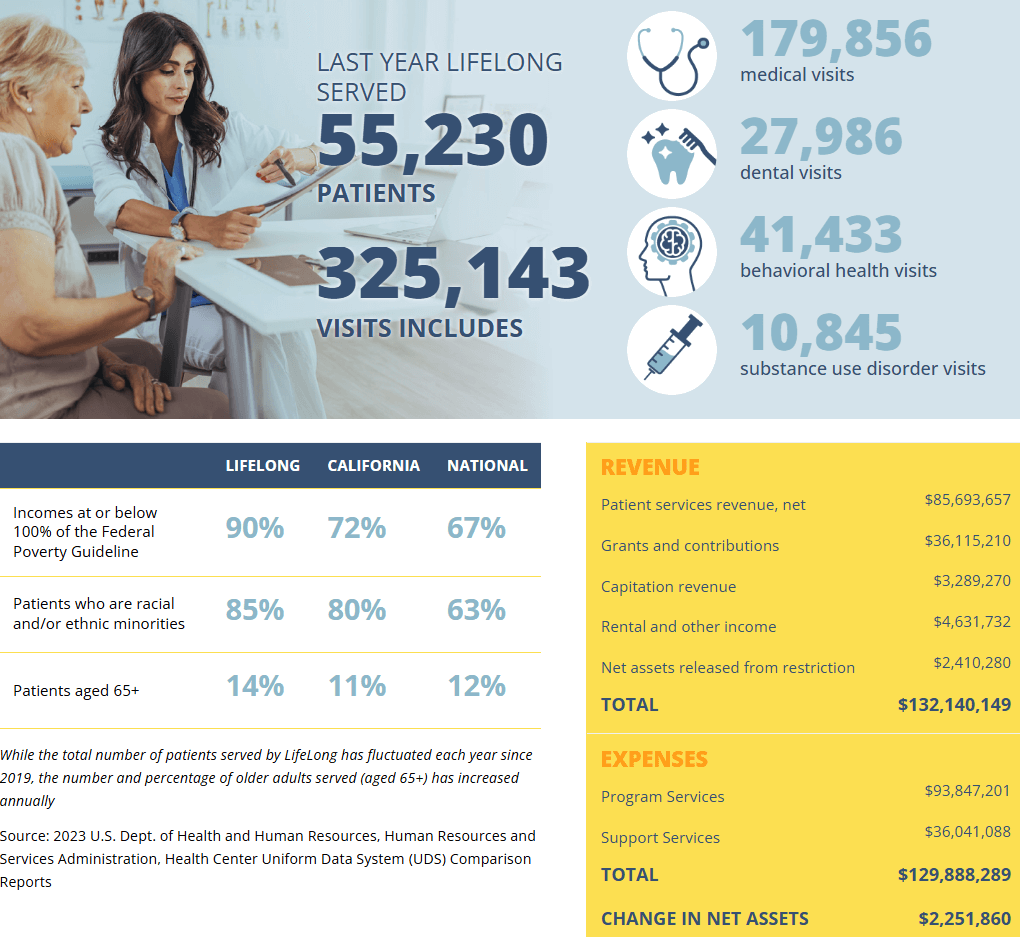
At a glance, readers can see information about patients served, the type of care provided, and financial assets.
Be clear about how you’re using funds
Take every opportunity you can to show supporters how you use donations. For example, you might include a footer graphic on your website that demonstrates how you allocate funds, as the Doctors Without Borders site does:

You could also create a blog post to recap a recent fundraising event and describe how you used donations to help fund the remodel of your hospital waiting room. When you promote transparency across digital platforms like your website, email, and social media, you’ll be able to reach a wider audience and further enhance your credibility.
Share your successes and challenges
Overemphasizing your organization’s successes without addressing your challenges can appear insincere. Stakeholders will appreciate your efforts to be honest about any obstacles you’re facing, especially when you provide a detailed plan for mitigating or addressing these roadblocks.
For example, you might address challenges you’ve faced in diversifying your fundraising sources and how you plan to engage in a broader range of revenue opportunities to stabilize your funding.
How to get expert healthcare fundraising help
As you can see, recent industry challenges, shifting external factors, and patient expectations have created a challenging fundraising landscape for healthcare organizations. However, these obstacles aren’t insurmountable, especially with the help of an experienced consultant by your side.
The BWF team is ready to support your fundraising efforts at any level. We work with a wide variety of healthcare organizations, including health systems, research facilities, children’s hospitals, and health-focused NGOs.
Whether you need to revamp your internal systems and analytics, improve your approach to predictive modeling, or keep up with the latest healthcare fundraising trends, our team can provide the expertise you need to grow your fundraising results. We have over 40 years of experience assisting healthcare organizations with the following fundraising efforts:
- Grateful patient programs
- Fundraising campaigns
- Major gift strategies
- CRM implementations
- Facilitated access programs
- Data science
- Prospect research
In conclusion
Healthcare fundraising constantly evolves as your patient and supporter bases shift over time. These tips will help you remain flexible and adapt to new opportunities as they arise.
Looking for more healthcare fundraising tips? Review these additional resources:
- How to Unlock the Power of AI Fundraising: A Complete Guide. Explore how AI fundraising tools can help you better reach your target audience and predict fundraising outcomes.
- Partners in Philanthropy: The Hospital/Health System CEO and CDO. Partnerships between the hospital or health system chief executive officer and the foundation head or chief development officer are essential for productive healthcare fundraising campaigns. Hire the right CDO and leverage their skills effectively with the tips in this guide.
- Digital Fundraising: 10+ Revolutionary Campaign Ideas. A digital fundraising campaign can be just what your healthcare organization needs to revamp its fundraising efforts. Plan a successful campaign with these ideas and tips.
Let’s Talk
Meet with the BWF team to discuss your healthcare fundraising goals.



